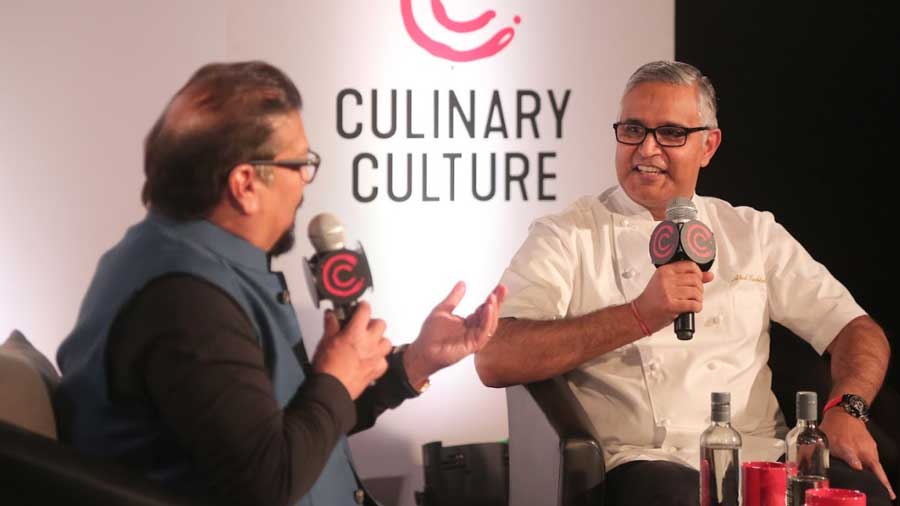Atul Kochhar’s story is not just a story of brilliance, it’s a story of innovation.
The Michelin star chef took a different kind of Indian food to England. He invented modern Indian food and the way it was plated. He brought ingredients we never thought of into Indian food and explored the cuisines of India. He’s been the victim of injustices and faced reversals but he’s always bounced back.
In the latest session of #CulinaryConversations held in Delhi’s Roseate House on November 27, put together by Culinary Culture, which is India’s “biggest and most definite culinary platform” founded by Sameer Sain and chaired by Vir Sanghvi, the members (who are called #FoodHunters, including this writer), were witness to yet another riveting conversation on the making of a chef.
Enter, Atul Kochhar in a no-holds-barred chat with editor, writer and celebrity TV host Vir Sanghvi. Excerpts…
Atul in the making
Vir: How did the ‘big break’ of moving to London happen?
I was sitting one afternoon chatting with chef Navin Bhatia, who was my mentor. He told me about a job offer in London and how they were looking for a young and unmarried chef. I met the owner, Mr Khanna, who asked me to cater for a party of 20 at his home. They liked me and the food. I had six months left on my contract with The Oberoi Group. Three months later, Khanna called me and said, ‘Your visa’s here and you’re leaving next week’. I told them that’s not happening! They said, ‘We’ve spoken to Mr Oberoi and you’re safe to fly!’
I took his word for it and flew out. Later, I heard that Mr Oberoi was hunting for me with a double barrel gun (laughs). I met Mr Oberoi 10 years later and he laughed it off: ‘You did what you did and you did well. We’re proud of you’.
Vir: When you arrived in London, Tamarind was opening in Mayfair, which is one of the most expensive areas and the prices would reflect that. Suddenly you were going to do real Indian food and not Bangladeshi Indian food. How did that feel?
Sometimes, ignorance is bliss! Having trained in Oberoi’s, I had the confidence to do the right thing despite being in the vicinity of (British celebrity chef) Marco Pierre White and (French celebrity chef) Jean-Christophe Novelli. As soon as I opened the restaurant, my vegetable supplier swung by and said, ‘By the way, I’ve told my wife there’s a fantastic curry house that’s opened in Mayfair and I’m taking you out!’ So I knew where I stood!
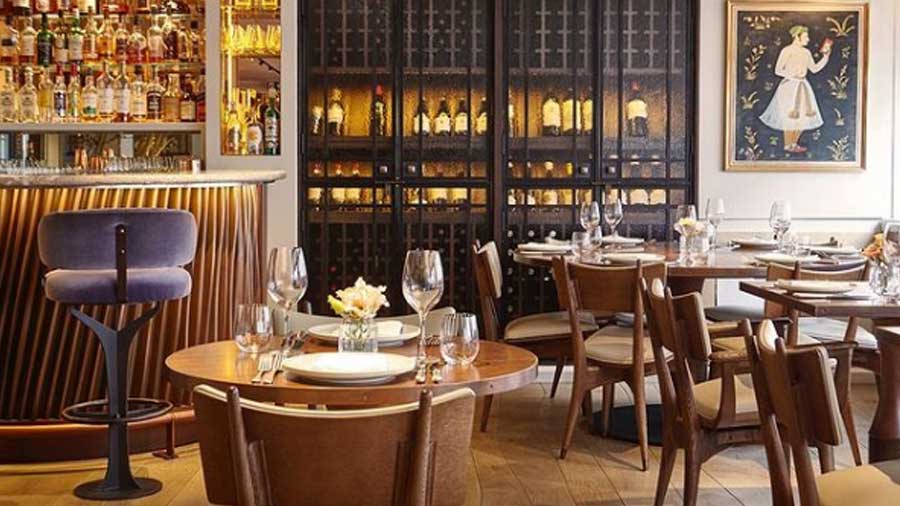
London's Tamarind restaurant serves up a modern twist on the flavours and textures of India. In 2001, Atul became the first Indian chef to get the coveted Michelin star as head chef at Tamarind @tamarindofmayfair/Instagram
Vir: Then your father comes to visit...
Typical Indian dad, didn’t tell me he’s coming! Landed in Heathrow and said, ‘I’ll be home in two hours’. He shows up at Tamarind and says, ‘Let’s eat lunch together. Cook me a three-course meal’. So, I cooked and watched his face through the large kitchen window at Tamarind. I saw his jaw bone going up and down and thought, ‘He’s going to chew me today!’ After the meal, he asked if we could go for a walk. Whenever I got told off by him, we went for long walks so I knew what was coming. He took me to Hyde Park and those of you who know the park, I did three rounds of it!
When he saw my menu, I think he wasn’t very happy. I looked at it from his point of view, which is: ‘You’re a Punjabi boy, born in Jamshedpur, which is east India. I purposely sent you to Chennai to study so you could understand your own country. And you trained with some of the best chefs in Oberoi. So what is your menu doing?’
I told him that food critics Fay Maschler gave me four stars and Jonathan Gold gave me five stars. He said, ‘I’m not going to dispute that, I am sure they know what they’re looking for. But are you happy doing what you are doing? If I say you have pomfret on your menu, where does it come from? It comes frozen from India. Have you ever been to Marco Pierre White’s restaurant? They don’t grow anything that doesn’t grow outside this country. When you were in Jamshedpur, you were using local produce and cooking with that.’

I got a call from the Evening Standard editor and he told me that I’ve got a Michelin star. I said, ‘The next thing you’re going to tell me is that I am going to be King of England. I'm not listening to you, I've got three bags of onions to peel’.
Atul Kochhar
It gave me the sense that I was wrong somewhere and I had not tried to use the local agriculture and geographical location to my benefit. I wasn't working with seasons. I was ashamed that in spite of being his son, I had not learnt well. So after he left, I went on a rampage. I went to the North Sea on a small dinghy boat. It’s a rough sea and I was sick many times trying to pull the net back. I worked with farmers and understood agriculture. I started using ingredients according to the season. My menus got shorter and I started focusing more on natural flavours.
The result of that showed in 2001 when I got a call from the Evening Standard editor and he told me that I’ve got a Michelin star.
I said, ‘The next thing you’re going to tell me is that I am going to be King of England. I'm not listening to you, I've got three bags of onions to peel’.
Vir: Until that point no Indian restaurant had got a Michelin star. Did you know that a Michelin inspector was in the room?
I had no idea, I had no rulebook. We were doing what we did heartily and enjoyed our work. Those three years of my life, I worked without pressure. And I promised myself that’s how I'm going to always work.
Vir: Once you got the star, were you worried about losing it?
For the first couple of years, yes! Every time there was a single customer, we thought this must be a Michelin inspector!
Vir: People say that Michelin looks for certain things like a big dessert menu, a certain level of service, a wine list that matches their standards…
Initially, I was just doing what I was doing. There was no science behind it. I made a 33 per cent rule for myself - food, ambience and service have to be in sync. There has to be creativity on the plate, a sense of seasonality, you have to be a chef who’s proud of his food. If you cook a piece of fish, put it proudly on the plate and not under the sauce.
Vir: Do chefs really use those many four-letter words in the British kitchen?
Gordon (Ramsay) definitely hams it up for the camera. I’ve worked with Gordon several times and he’s polite and cool as a cucumber but the moment you show him a camera, his real vocabulary comes out!
Atul the entrepreneur
Vir: Phase 2 is Benares. You founded this restaurant in Berkeley’s Square, became a partner and you made it work. Tell us more.
When I was offered the opportunity to open Benares with this individual, I told my present employer, Mr Khanna, that if I could be given share holding I'd be happy to stay. That didn’t happen so after an honest conversation, I moved on.
Benares was an ambitious project - it was 6,000sq ft. I was more of a chef than an entrepreneur and I had no idea what I was getting into. I was more interested in the kitchen than the dining room and had no idea how the aesthetics worked. Interestingly, neither did my business partner because he was a banker.

Atul mortgaged his house to fund Benares. In 2006, he got his second Michelin star at the modern Indian cuisine restaurant in London's Berkeley’s Square.
Halfway through, I was told, ‘Sorry, the money has run out. The kitchen is ready so start cooking because we have to bring in more money.’
The restaurant now has a huge flight of stairs that go up. The stones were not there when we opened the restaurant and we painted the iron red so that it looked presentable. When people visited, they expected a lot - the food was okay but the ambience was not okay. Fay called me on the side, sighed and said, ‘Your Benares will meet your own Benares one day!’
I reached a stage where I was having a lot of stress. When I asked for more money, my partner at Benares said, ‘You have to bring in more money’. I was a junior partner but I went out with a begging bowl. I brought in a college mate of mine, Ashish Diwan, who invested close to half a million and I mortgaged my house and brought in the rest. Then we turned the restaurant around. In 2006, we got a Michelin star and we never looked back.
Atul 2.0
You were 49 and you’d already won two Michelin stars. You could have opened Kanishka (2019) as just another Atul Kochhar restaurant. Instead you go back to Indian cuisine and find things that no one’s done before. Why?
I think I have a bug! It would have been a lazy approach if I had just put the Benares menu there. I like to work hard. I knew I wasn’t going to repeat Punjabi food (Tamarind) or modern Indian cuisine (Benares). Being an east Indian boy, I still had a huge affinity to my east Indian upbringing. I looked upon Assam, Nagaland, Arunachal Pradesh and Tripura and thought about how we have never explored this cuisine. I started researching that food and found it very interesting. We came up with the Seven Sisters menu and Kanishka (Maddox Street, London) was a huge hit.
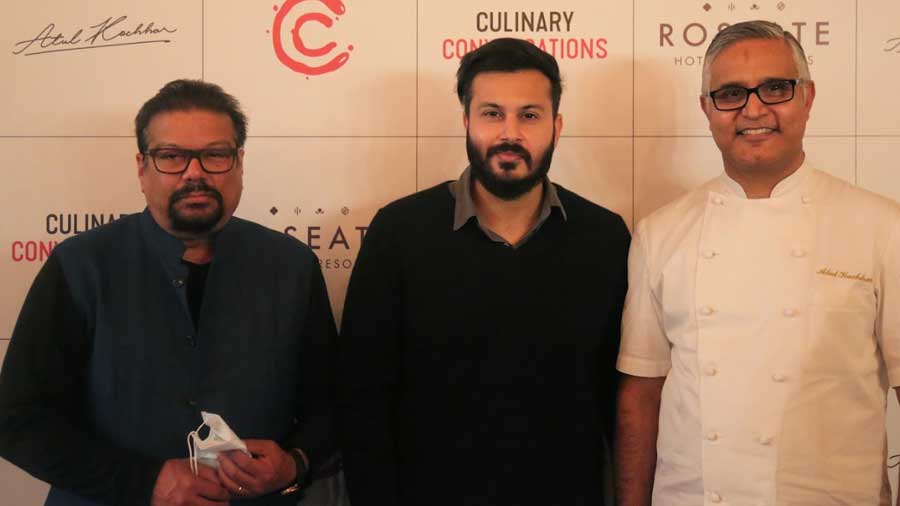
The faces of Culinary Culture: Vir Sanghvi, chairman, and Raaj Sanghvi, CEO, with chef Atul Kochhar
What next?
I have around four-five restaurants in the pipeline, the fifth one is being negotiated. I have also managed to write my book, it’s called Curry Everyday: Over 100 simple vegetarian recipes from Jaipur to Japan, set to release in March 2022. I wrote a book called Curries of the World around 10 years ago and it was quite a hit.
A few questions from the Food Hunters of Culinary Culture…
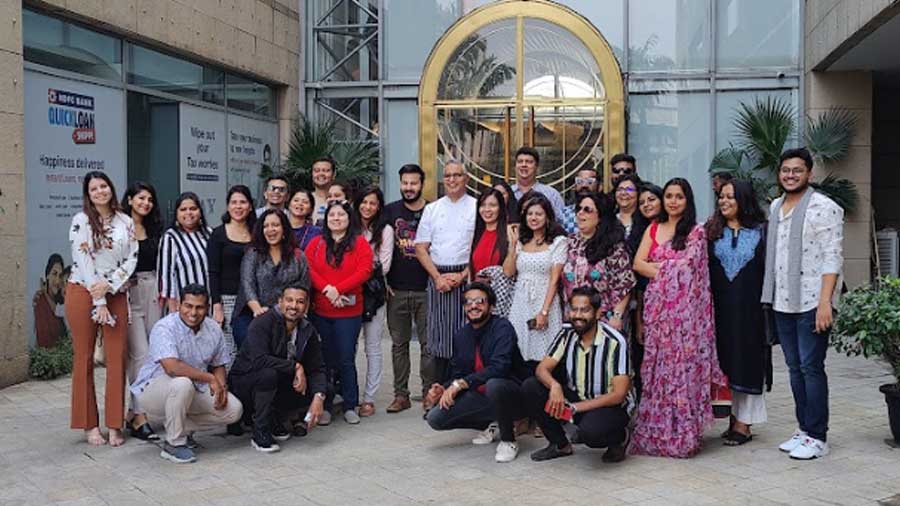
The Food Hunters of Culinary Culture comprise food writers, bloggers, vloggers and food lovers from 28+ Indian states. The team was hosted at Kochhar's new modern Indian outlet SAGA in Gurgaon
Is it that much more difficult for a chef like you to earn a Michelin star as compared to an Italian chef who has specialised in a particular line?
The large size of our country and the sub cultures make it that much more challenging to learn. Even at 49, I had to explore a lot. Yes, other chefs may have a smaller space to explore but the fun is where the variety is. I could have 26 dishes and each one could represent a different state!
How is the name of a restaurant decided? Why is a Punjabi restaurant called Tamarind?
Sometimes, it’s the entrepreneur’s decision. When Mr Khanna told me about Tamarind, I asked if it would be a south Indian restaurant! He loved the name so we went with it. Benares was a huge cultural centre and easy to pronounce so we chose that together. When I opened Kanishka’s, it symbolised the golden era of economy. About Saga (a venture with restaurateur Vishal Anand in Gurgaon) when Vishal and I met, I told him I'm a huge fan of food stories and that’s how the name was born.
Finally, is George Clooney as good-looking in real life?
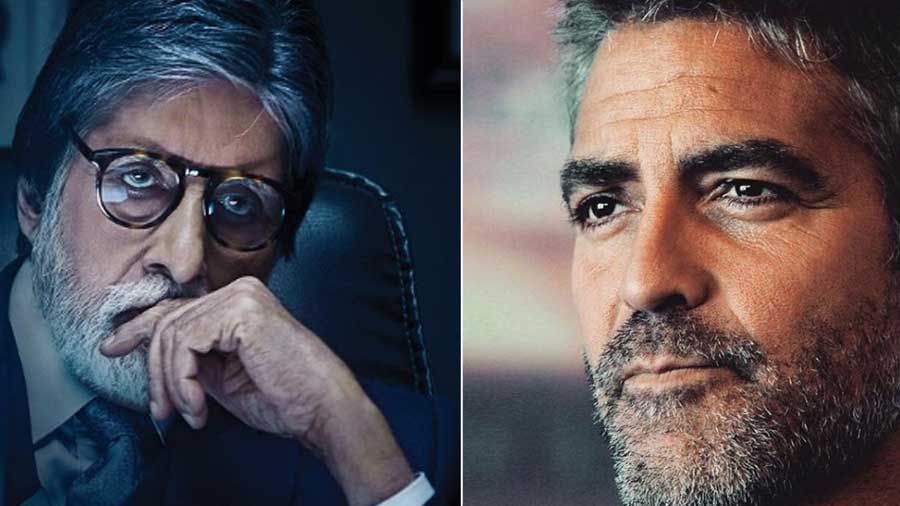
The list of celebs Kochhar has cooked for include Amitabh Bachchan and George Clooney
That’s a delicious culinary question (laughs). Yes, I have cooked for him several times, I think he’s better looking in life than on screen. I don’t like name-dropping but I can mention my favourites. Dustin Hoffman is my favourite. I love him to bits, he’s a great actor. Among Indian celebrities, cooking for Amit ji (Amitabh Bachchan) has always been interesting because he’s vegetarian. And I could never get his salt right. He may have made Cheeni Kum but his salt is always less!
